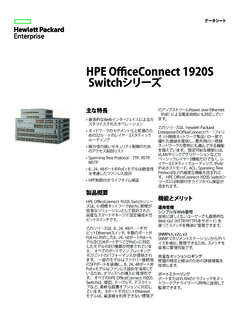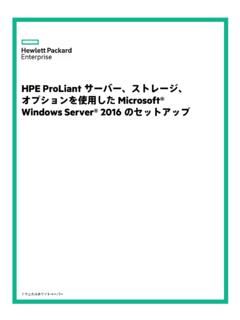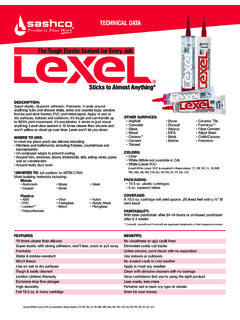Transcription of HPE 5130 HI Switch Series data sheet
1 Data sheet HPE FlexNetwork 5130 HI. Switch Series Key features Scalable with 10 Gigabit uplinks and nine-chassis IRF with up to 80 Gbps stacking bandwidth PoE+ for up to 30 W of PoE power per port on all ports simultaneously Four convenient built-in SFP+ 10 GbE uplinks provide performance for bandwidth hungry applications OpenFlow support MACsec support Product overview The HPE FlexNetwork 5130 hi switch series comprises Gigabit Ethernet switches that support static and RIP Layer 3 routing, diversified services, and IPv6 forwarding, as well as provide four 10 Gigabit Ethernet (10 GbE) interfaces. Unique Intelligent Resilient Fabric (IRF) technology creates a virtual fabric by managing several switches as one logical device, which increases network resilience, performance, and availability, while reducing operational complexity.
2 These switches provide Gigabit Ethernet access and can be used at the edge of a network or to connect server clusters in small data centers. High availability, simplified management, and comprehensive security control policies are among the key features that distinguish this Series . This Switch also supports dual modular power supplies. Data sheet Page 2. Features and benefits Software-defined networking OpenFlow Supports OpenFlow specification to enable SDN by allowing separation of the data (packet forwarding) and control (routing decision) paths Quality of Service (QoS). Broadcast control Allows limitation of broadcast traffic rate to cut down on unwanted network broadcast traffic Advanced classifier-based QoS. Classifies traffic using multiple match criteria based on Layers 2, 3, and 4 information; applies QoS policies such as setting priority level and rate limit to selected traffic on a port, VLAN, or entire Switch Powerful QoS feature Supports the following congestion actions: strict priority (SP) queuing, weighted round robin (WRR), and SP+WRR.
3 Traffic policing Supports Committed Access Rate (CAR) and line rate Management Remote configuration and management Enables configuration and management through a secure Web browser or a CLI located on a remote device Manager and operator privilege levels Provides read-only (operator) and read/write (manager) access on CLI and Web browser management interfaces Command authorization Leverages RADIUS/HWTACACS to link a custom list of CLI commands to an individual network administrator's login; also provides an audit trail Secure Web GUI. Provides a secure, easy-to-use graphical interface for configuring the module via HTTPS. Multiple configuration files Stores easily to the flash image Complete session logging Provides detailed information for problem identification and resolution Remote monitoring (RMON).
4 Uses standard SNMP to monitor essential network functions; supports events, alarm, history, and statistics group plus a private alarm extension group Data sheet Page 3. IEEE Link Layer Discovery Protocol (LLDP). Advertises and receives management information from adjacent devices on a network, facilitating easy mapping by network management applications sFlow (RFC 3176). Provides scalable ASIC-based wirespeed network monitoring and accounting with no impact on network performance; this allows network operators to gather a variety of sophisticated network statistics and information for capacity planning and real-time network monitoring purposes Management VLAN. Segments traffic to and from management interfaces, including CLI/Telnet, a Web browser interface, and SNMP.
5 Remote intelligent mirroring Mirrors ingress/egress ACL-selected traffic from a Switch port or VLAN to a local or remote Switch port anywhere on the network Device Link Detection Protocol (DLDP). Monitors a cable between two compatible switches and shuts down the ports on both ends if the cable is broken, which prevents network problems such as loops IPv6 management Provides future-proof networking because the Switch is capable of being managed whether the attached network is running IPv4 or IPv6; supports pingv6, tracertv6, Telnetv6, TFTPv6, DNSv6, syslogv6, FTPv6, SNMPv6, DHCPv6, and RADIUS for IPv6. Troubleshooting Ingress and egress port monitoring enables network problem-solving; virtual cable tests provide visibility into cable problems HPE Intelligent Management Center (IMC).
6 Integrates fault management, element configuration, and network monitoring from a central vantage point; built-in support for third-party devices enables network administrators to centrally manage all network elements with a variety of automated tasks, including discovery, categorization, baseline configurations, and software images; the software also provides configuration comparison tools, version tracking, change alerts, and more Connectivity Auto-MDIX. Automatically adjusts for straight-through or crossover cables on all 10/100/1000 ports Flow Control Provides back pressure using standard IEEE , reducing congestion in heavy traffic situations High-density connectivity Provides up to 48 fixed 10/100/1000 BASE-T ports in a Layer 2/Lite Layer 3 Switch Data sheet Page 4.
7 IEEE Power over Ethernet (PoE+) support Simplifies deployment and dramatically reduces installation costs by helping to eliminate the time and cost involved in supplying local power at each access point location Ethernet operations, administration, and maintenance (OAM). Detects data link layer problems that occurred in the last mile using the IEEE OAM. standard; monitors the status of the link between two devices Performance Non-blocking architecture Up to 216 Gbps non-blocking switching fabric provides wirespeed switching with up to million pps throughput Hardware-based wirespeed access control lists (ACLs). Help provide high levels of security and ease of administration without impacting network performance with a feature-rich TCAM-based ACL implementation Resiliency and high availability Separate data and control paths Separates control from services and keeps service processing isolated; increases security and performance Smart Link Allows under 100 ms failover between links Spanning Tree/PVST+, MSTP, RSTP.
8 Provides redundant links while preventing network loops Intelligent Resilient Fabric (IRF). Creates virtual resilient switching fabrics, where two to nine switches perform as a single L2 Switch and L3 router; switches do not have to be colocated and can be part of a disaster-recovery system;. servers or switches can be attached using standard LACP for automatic load balancing and high availability; can eliminate need for complex protocols like Spanning Tree Protocol, Equal-Cost Multipath (ECMP), or VRRP, thereby simplifying network operation Internal Dual Redundant Power Supply Provides high reliability by keeping network up while delivering up to 1440 W of PoE+. Manageability Dual-flash images Provides independent primary and secondary operating system files for backup while upgrading Multiple configuration files Allow multiple configuration files to be stored to a flash image Data sheet Page 5.
9 IPv6 management Future-proofs networking, as the Switch is capable of being managed whether the attached network is running IPv4 or IPv6; supports pingv6, tracertv6, Telnetv6, TFTPv6, DNSv6, and ARPv6. Troubleshooting Allows ingress and egress port monitoring, enabling network problem solving; virtual cable tests provide visibility into cable problems Layer 2 switching 32K MAC address table Provides access to many Layer 2 devices VLAN support and tagging Supports IEEE with 4094 simultaneous VLAN IDs IEEE QinQ and selective QinQ. Increase the scalability of an Ethernet network by providing a hierarchical structure; connect multiple LANs on a high-speed campus or metro network 10 GbE port aggregation Allows grouping of ports to increase overall data throughput to a remote device Device Link Detection Protocol (DLDP).
10 Monitors link connectivity and shuts down ports at both ends if unidirectional traffic is detected, preventing loops in STP-based networks Jumbo frame support Improves the performance of large data transfers; supports frame size of up to 9K bytes Layer 3 services Address Resolution Protocol (ARP). Determines the MAC address of another IP host in the same subnet; supports static ARPs;. gratuitous ARP allows detection of duplicate IP addresses; proxy ARP allows normal ARP operation between subnets or when subnets are separated by a Layer 2 network Dynamic Host Configuration Protocol (DHCP). Simplifies the management of large IP networks; supports client; DHCP Relay enables DHCP. operation across subnets Loopback interface address Defines an address that can always be reachable, improving diagnostic capability User Datagram Protocol (UDP) helper function Allows UDP broadcasts to be directed across router interfaces to specific IP unicast or subnet broadcast addresses and prevents server spoofing for UDP services such as DHCP.















